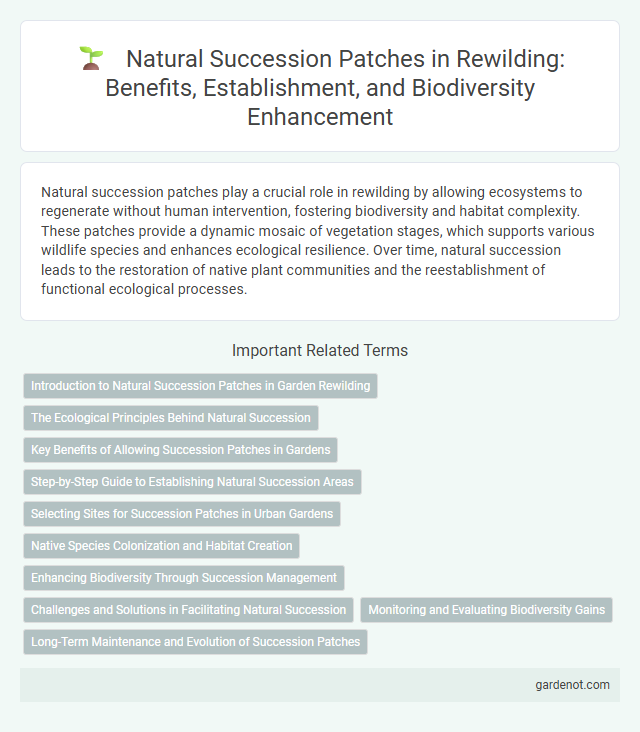Natural succession patches play a crucial role in rewilding by allowing ecosystems to regenerate without human intervention, fostering biodiversity and habitat complexity. These patches provide a dynamic mosaic of vegetation stages, which supports various wildlife species and enhances ecological resilience. Over time, natural succession leads to the restoration of native plant communities and the reestablishment of functional ecological processes.
Introduction to Natural Succession Patches in Garden Rewilding
Natural succession patches in garden rewilding foster biodiversity by allowing native plants to colonize and mature naturally without human intervention. These patches create dynamic habitats that support various wildlife species, enhancing ecological resilience. Promoting natural succession helps restore soil health and encourages ecosystem processes critical for sustainable garden landscapes.
The Ecological Principles Behind Natural Succession
Natural succession follows key ecological principles such as species colonization, resource availability, and competition dynamics, driving the gradual transformation of ecosystems. Pioneer species establish initial patches, facilitating conditions for subsequent species by modifying soil composition and microclimate. This patch-based process enhances biodiversity, ecosystem resilience, and habitat complexity essential for rewilding success.
Key Benefits of Allowing Succession Patches in Gardens
Allowing natural succession patches in gardens enhances biodiversity by creating diverse habitats that support native flora and fauna. These patches improve soil health through organic matter accumulation and nutrient cycling, fostering a resilient and self-sustaining ecosystem. Succession areas also increase pollinator presence, which benefits surrounding plants and contributes to overall garden productivity.
Step-by-Step Guide to Establishing Natural Succession Areas
Establishing natural succession areas requires selecting degraded or abandoned lands with minimal human disturbance to promote ecological restoration. Begin by assessing soil quality, native seed banks, and existing vegetation before halting intensive land management practices such as mowing or pesticide use. Monitor biodiversity changes and soil health regularly to ensure progressive habitat development and ecosystem resilience over time.
Selecting Sites for Succession Patches in Urban Gardens
Selecting sites for succession patches in urban gardens involves identifying areas with minimal human disturbance and diverse microhabitats that support native flora and fauna. Optimal locations often include underutilized corners, abandoned lots, or buffer zones near natural water sources, which facilitate natural succession processes and enhance biodiversity. Prioritizing soil quality, sunlight exposure, and connectivity to other green spaces maximizes ecological resilience and promotes long-term habitat restoration.
Native Species Colonization and Habitat Creation
Natural succession patches facilitate the colonization of native species by providing undisturbed environments where indigenous plants and animals can establish and thrive. These areas promote habitat creation by supporting diverse microhabitats essential for native biodiversity, including pollinators, birds, and small mammals. Rewilding efforts emphasize natural succession as a key process to restore ecological balance and enhance ecosystem resilience.
Enhancing Biodiversity Through Succession Management
Natural succession patches play a crucial role in enhancing biodiversity by creating diverse habitats that support a wide range of flora and fauna. Effective succession management encourages the gradual development of native vegetation, allowing ecosystems to recover and stabilize naturally over time. This process increases species richness and ecosystem resilience, fostering a balanced and self-sustaining environment essential for rewilding projects.
Challenges and Solutions in Facilitating Natural Succession
Natural succession patches face challenges such as invasive species dominance, nutrient imbalances, and fragmented habitats that disrupt ecological processes. Implementing adaptive management techniques, like targeted removal of invasive plants, soil restoration, and creating wildlife corridors, enhances habitat connectivity and resilience. Continuous monitoring and community involvement support the recovery of native species and accelerate ecosystem complexity in rewilding projects.
Monitoring and Evaluating Biodiversity Gains
Natural succession patches serve as dynamic indicators for tracking ecosystem restoration by enabling continuous monitoring of species composition and habitat complexity. Employ methods like remote sensing and in situ biodiversity surveys to evaluate ecological indicators such as species richness, functional traits, and keystone species presence. Quantitative analysis of these data sets supports adaptive management, ensuring measurable biodiversity gains during rewilding projects.
Long-Term Maintenance and Evolution of Succession Patches
Natural succession patches undergo continuous ecological processes that promote biodiversity and habitat complexity over decades. Long-term maintenance relies on minimal human intervention, allowing native species to establish and evolve naturally within dynamic environmental conditions. Monitoring these patches ensures the preservation of successional stages critical for ecosystem resilience and adaptive capacity.
Natural succession patch Infographic

 gardenot.com
gardenot.com